
When faced with having to explain something that feels like it should be big — like, say, the vote to deny a First Nations Voice — Australia’s media lurched for the comfort of the easy explanation of proximate causes that let them look away from confronting the challenging questions of history and power.
So it’s been with Saturday’s result, marking the collapse of an almost 30-year reconciliation project. We’re being offered not one, but three choices: blame it on the century-long inertia of partisan referendum failure; blame it on the decisions of the Yes campaign (or, better yet, blame Prime Minister Anthony Albanese for forcing us to vote); or blame it on the maligned campaign of misinformation from the No partisans.
Each choice has the luxury of pandering to priors. Each (particularly the role of often racist misinformation) has the benefit of having just enough supporting evidence to be satisfying. And all offer the comfort of letting the news media (and everyone else, for that matter) off the hook.
It’s a blindly unselfconscious, non-Indigenous journalism suiting up, hot dog meme guy-style, to assure audiences that we’re just all trying to find who did this.
The finger-pointing is just a continuation of the same failures of understanding that have marked the media’s reporting of the Voice since Albanese’s election night speech finally woke up journalism’s opinion leaders to what was going on.
Until that moment, the long march of the Uluru Statement from the Heart through the Australian community had been reported and analysed with nuance and care by a handful of engaged reporters, such as the ABC’s Patricia Karvelas or Paige Taylor in The Australian. News Corp’s Chris Kenny worked constructively in the consultation process run by Ken Wyatt under the Morrison government (and remained a rare passionate advocate within the US company for the cause.)
Suddenly, with the new PM’s announcement, the gallery discovered its own voice. It picked up the peoples-to-peoples invitation of the Uluru Statement, turned it over, ruminated on it for a moment or two and then tossed it into the box marked “big P-party politics”. Once trapped in that gallery vortex, the Statement from the Heart was stripped of what gave it strength — its grounding in community — and was reforged as just another shiny gee-gaw to be tossed around in the parliamentary conflict that passes for the Canberra news cycle.
This media-driven reframing drove everything that followed. As Niki Savva wrote last week, it made all but inevitable Opposition Leader Peter Dutton’s willing embrace of the opportunity to grandstand a No with increasingly false statements, as even the most cautious of reporters, such as the Nine newspapers’ David Crowe, was compelled to comment.
It wedged the Uluru leaders, wary of being caught out being angry, as Isabella Higgins patiently explained to her non-Indigenous panellists on ABC’s Insiders this weekend (and as Indigenous leader Professor Marcia Langton was reminded by News Corp’s civility police during the campaign).
It jemmied the coverage into the always useless balance of “both sides”, as one of the gallery’s better thinkers, Laura Tingle, called out in the referendum campaign’s dying days.
It gutted plans at the ABC, SBS and Nine mastheads to cover the Voice with a supportive “culmination of reconciliation” narrative, limiting the power and potential of a rising generation of Indigenous journalists — such as the ABC’s outstanding Voice reporter Dan Bourchier — to light up our understanding. It drove Stan Grant out of broadcasting.
Opposing recognition turned out to be as easy as Indigenous activist and leader Noel Pearson foretold in last year’s Boyer lectures: “An inane thing to do — but easy. A heartless thing to do — but easy.”
It was a tragedy for the Uluru Statement which was developed and designed by First Nations peoples with the hope that it could break through the wall of culture wars and politicisation of Indigenous policy erected by the Howard government, reaching out a hand past political gatekeepers to non-Indigenous Australians.
The reward of the Indigenous-led Yes case for its offering was to be sneered at by much of the non-Indigenous professional political class and its pundit hangers-on for not understanding how “real politics” should be done in Australia.
It made it a broader tragedy for anyone who hopes for the sort of different way of doing politics that the Uluru Statement offered — one grounded on the agency and passions of an active citizenry, rather than a passive hand-me-down from Canberra’s national triangle mediated through social media.
It was a tragedy, too, for those of us who yearn for a better way of doing journalism, one bottom-up, not top-down, one better suited for shaping and telling our national narrative.
It leaves Australian settler media — and that’s most of us — trapped in an enduring liminal space between colonial and coloniser. Sure, it’s a media that’s done its job of building the “we are one and free” national narrative of what “Australia” means. It’s belatedly stretched that narrative back with a passive recognition of the previous 65,000 years of human occupation of the continent.
But while we like to think we’ve sloughed off our past colonial dependency, last Saturday showed we’ve still got a long way to go to shake the coloniser mindset out of our narrative.
Is it fair to sheet home the blame on Australia’s media? Or did political misinformation do its share of damage? Let us know by writing to letters@crikey.com.au. Please include your full name to be considered for publication. We reserve the right to edit for length and clarity.







